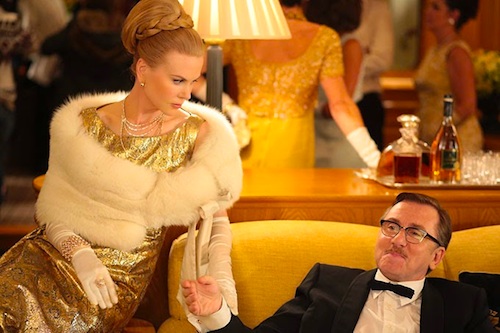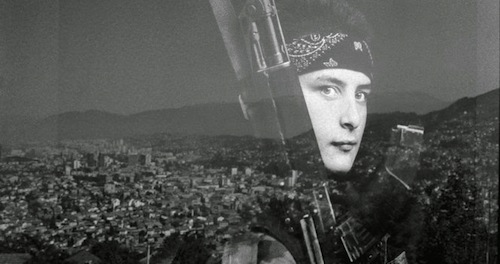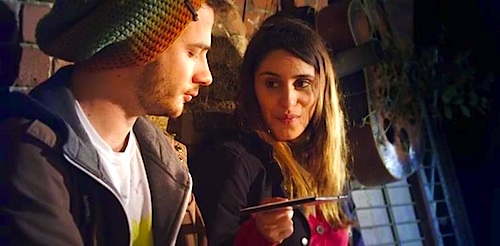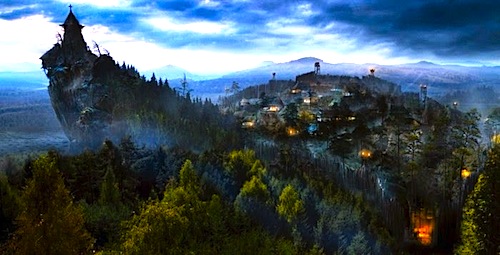By Joe Bendel. Duane Jones only had two lead roles in his trailblazing film career, but they were both truly iconic for genre film connoisseurs. The first was George Romero’s enduringly popular Night of the Living Dead. Remaking such a familiar film was a perilous proposition, as both makeup artist Tom Savini and team of filmmakers not affiliated with Romero have proved on separate occasions. Bill Gunn’s Ganja & Hess is a different story. Less well known, the 1973 experimental exploitation film exists in both director and studio cuts, making issues of authenticity more complicated. Nevertheless, Spike Lee remains devotedly faithful to Gunn’s narrative throughout Da Sweet Blood of Jesus, which releases today on DVD and BluRay.
Dr. Hess Greene is an independently wealthy anthropologist, who specializes in the Ashanti people and their cultural obsession with blood (which Dr. Wiki has never heard of). He is about to commence a major research project when his jittery new research assistant, Dr. Lafayette Hightower stabs him repeatedly with a ceremonial Ashanti knife, before blowing his brains out. Strangely, Dr. Greene does not die. He merely wakes up rather the worse for wear, with a powerful thirst—for blood.
Eventually, Hightower’s hot but cold ex-wife Ganja comes looking for her disappointing former husband, but finds the very rich and highly interested Greene instead. Of course, he also happens to be undead. As they fall for each other he starts planning for their eternal future together, but Greene’s new existence will become more draining (in more ways than one) than he ever anticipated.
Yes, Ganja and Hess will essentially become vampires, but neither film really plays up the traditional Universal/Hammer/Anne Rice motifs. These are very existential vampires, isolated by privilege and addiction, like Howard Hughes or Brian Wilson. It is never exactly scary, but there are several sly “here-it-comes” moments. Lee also manages to maintain a distinctively icy vibe throughout the film.
Arguably, the best thing going for Sweet Blood is its soundtrack. This is easily Bruce Hornsby’s best and most jazz-oriented film work yet. Featuring contributions from prominent musicians like Vernon Reid on guitar, Lew Soloff on trumpet, Esther Noh on violin, Clark Gayton on trombone, and Patience Higgins and Stacy Dillard on tenor, it often sounds somewhat akin to his terrific debut jazz release, Camp Meeting.
If that were not enough, the soundtrack also includes licensed tracks from Milton Nascimento’s Journey to Dawn album, as well as performances from the church band previously seen in Red Hook Summer, with Jonathan Batiste returning as the Hammond B3 organist, “TK Hazelton.” It all might sound too upbeat and soulful for a tale of quiet undead desperation, but it really helps pull viewers through many scenes that would otherwise be rather slow and aesthetically severe.

From time to time, Sweet Blood does indeed intersect with the world of Red Hook. Considering how painful his last original narrative film truly was, this would sound like a very bad idea on paper. Yet, the excursions to the “Little Church” give the new film greater depth and heart. Frankly, unlike Lee’s ill-advised remake of Park Chan-wook’s Oldboy, Sweet Blood is a pretty good film. Perhaps it is time Lee swore off originals and just stuck to reboots and sports docs.
As Greene, Stephen Tyrone Williams is cold fish, by design, but almost to a fault. However, it is great fun to watch Zaraah Abrahams ravenously chew the scenery Ganja Hightower, the temptress who will not be denied. Naté Bova also makes a strong impression as Tangier Chancellor, Hightower’s potential rival turned target of seduction. By genre standards, Sweet Blood is quite sensual, but Lee must have directed Abrahams’ horny-porny scene with Bova in a raincoat. It is the one time the film’s disciplined restraint goes out the window.
Be that as it is, Sweet Blood gets under the skin precisely because it is mostly so reserved and cold-blooded. It is not one hundred percent successful, but it is an intriguing outing from a filmmaker who hasn’t been interesting outside of New York sports documentaries for some time. Recommended for fans of Lee and Gunn’s 1973 cult classic, Da Sweet Blood of Jesus is now available on DVD from Anchor Bay and Gravitas Ventures.
LFM GRADE: B
Posted on May 28th, 2015 at 9:52pm.




